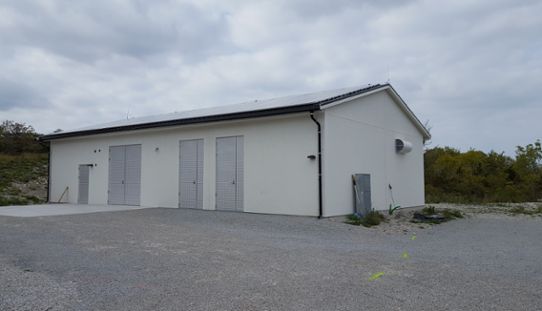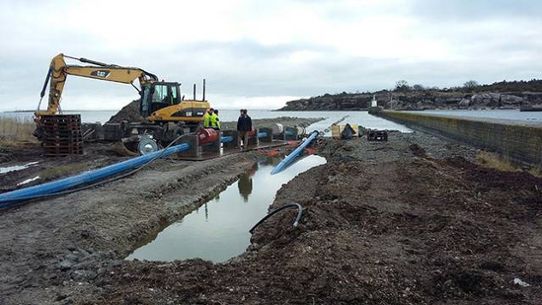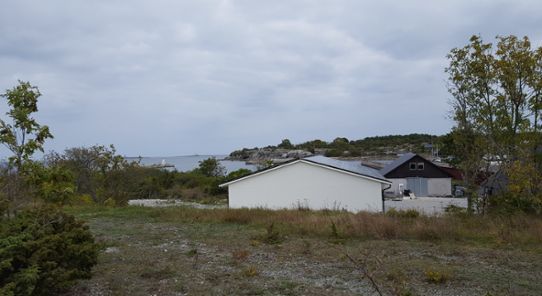After the dry summer of 2016, there is increasing interest in different solutions to the problem of finding more drinking water. On Öland, for example, geophysical instruments on helicopters are being used to search for new groundwater resources. Sweden’s first major desalination plant for producing drinking water from brackish water has begun operating in eastern Gotland. The water is to be sufficient for those who currently have their own wells and for visitors. The waterworks is said to have the capacity to supply about 2 000 people with water in Katthammarsvik and the Herrvik area. Region Gotland is now planning a significantly larger facility for 25 000 people on the western side of the island.

Lack of water hinders development
Katthammarsvik has long had a problem with its water supply and water quality. Each summer, water is driven there in tankers. In summer 2015, four tanker trucks per day were driven in, just over fifty cubic metres of water. At the same time, there is a desire to develop the area with both permanent homes and holiday accommodation. If this is to be possible, the water supply needs to be secured.

In its water and sewerage plan, Region Gotland has established that the water supply has a greater significance than the comprehensive plan for development on the island. Desalination of sea water is regarded as an important aspect of relieving the pressure on the local groundwater reservoir and expanding the supply of drinking water.

Desalination is a proven technology
The technology can be found in various parts of the world, normally using reverse osmosis. It is an energy-intensive process as the sea water is forced through small pores in a membrane. Using the brackish water from the Baltic Sea is beneficial as it has a lower concentration of ions that need to be removed than salty sea water. In Herrvik, solar panels have been installed to produce electricity for this energy-intensive process. Water use is greatest during the summer, which is also when the solar panels produce the most energy.
Several barriers in the process
In Herrvik, brackish water is pumped up from a depth of six metres and transported via a 200-metre-long pipeline to the shore and then into the desalination plant. As early as the inlet, there is a filter that only allows particles smaller than 2 mm to enter. The first stage of the purification process is an automatic filter and there is then an ultrafilter to gradually reduce the size of the particles. The ultrafilter also removes microorganisms.
The water then passes through the desalination membrane (reverse osmosis) that retains the ions while allowing the water molecules to pass through. High pressure (15–16 bar) is required for the water molecules to pass. The third stage is UV-light treatment to kill bacteria. The hardness and alkalinity are then adjusted. The concentration of minerals is increased by adding calcium and sodium hydrogen carbonate. This results in drinking water. It is also possible to treat the water with chlorine at the facility if necessary.
Disadvantages
Desalinating water is not uncontroversial. This is partly due to the large amount of energy required. That is why solar panels are used at Herrvik.
There are researchers who argue that the technology with regard to the mineralisation of the water must be developed. The drinking water producer is responsible for ensuring that the drinking water in the tap is of a good quality and safe to drink. The requirements placed on drinking water by the National Food Agency are fulfilled at Herrvik.
Other misgivings are that the concentrated salt solution that is returned to the sea may have a negative impact on the environment. However, the desalination plant in Herrvik is small and therefore probably has no impact on the seabed.
Costs
The desalination plant has cost approximately SEK 20 million and the total cost, including the intake and pipelines to consumers, is around SEK 30 million.
More examples of climate adaptation
This is one of many examples of climate adaptation. There are more in the collection of ideas being built up by the Swedish National Knowledge Centre for Climate Change Adaptation at the Swedish Meteorological and Hydrological Institute (SMHI). The collection of examples has the aim of sharing experiences and providing ideas to everyone who works with climate adaptation. Examples describe concrete measures and challenges in several subject areas. They show how different actors have worked to adapt their activities to the climate changes that are already being noticed today and those that we cannot prevent in the future.